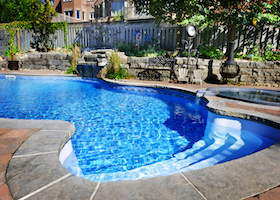
Clifton Water Trucking is proud to provide bulk water delivery for your storage tanks or pool. To estimate how much water you will need based on your tank’s volume, we have provided various formulas as well as the following water calculator:
The formula for calculating volume = length x width x depth. For more specific formulas based on the shape of your pool, see below.
Constant Depth Pools: Square or Rectangular
Length x width x depth x 7.5 = volume (in gallons)
To calculate the surface area of the pool, multiply the length by the width. Then, multiply that area by the depth to get the volume in cubic feet. Since there are 7.5 gallons in each cubic foot, multiply the cubic feet of the pool by 7.5 to determine the volume of the pool, stated in gallons.
Variable Depth Pools: Square and Rectangular
Length x width x average depth x 7.5 = volume (in gallons)
Measure the length, width, and average depth of the pool, rounding each measurement off to the nearest foot or percentage of one foot. One inch equals 0.0833 feet. Therefore, multiply the number of inches in your measurements by 0.0833 to get the appropriate percentage of one foot.
Example: 25 ft, 9 in. = 25 ft + (9 in. x 0.0833)
= 25 + 0.75
= 25.75 ft
How to Find the Average Depth:
Average depth = (Depth at the shallow end + Depth at the deep end) / 2
Example: If the shallow end is 3 feet deep and the deep end is 9 feet deep, assuming the slope of the pool bottom is gradual and even, then the average depth is 6 feet.
Average depth = (3 + 9) / 2 = 6 feet.
If most of the pool is only 3 or 4 feet deep and a small area drops off to 10 feet, you will have a different average depth. In this case, you may need to divide the pool into two separate parts. First, measure the length, width, and average depth of the shallow section. Then use the same measurements for the deeper section. Lastly, calculate the volume of the shallow part and add that to the volume you calculate for the deeper part.
Take extra precaution to ensure that you use the actual water depth in your calculations (not the container depth). This could mean serious errors when adding chemicals for example, which are administered based on the volume of water in question. There might be a time when you want to know the potential volume, if filled to the brim. Then, of course, you would use the actual depth (or average depth) measurement.
Circular Pools
The formula: 3.14 x radius squared x average depth x 7.5 = volume (in gallons)
The number 3.14 refers to pi, which is a mathematical constant. The radius is one-half the diameter. Measure the distance across the broadest part of the circle and divide it in half to get the radius. Squared means to be multiplied by itself, so you will multiply the radius by itself. For example, if you measure the radius as 5 feet, then multiply 5 feet by 5 feet to arrive at 25 feet.
Use the hot tub to calculate the volume of a round container. We will do that first. The diameter of the Jacuzzi is 10 feet. Half of that is 5 feet. Squared (multiplied by itself) means 5 feet times 5 feet equals 25 square feet. Knowing this, you can return to the formula:
3.14 x radius squared x average depth x 7.5 = volume (in gallons)
3.14 x 25 ft x 3 ft x 7.5 = 1766.25 gallons
If you are measuring the capacity of a circular spa you will have to follow these steps. First, you will need to calculate two or three areas within the hot tub, and then you will add them together to reach the total volume. Because the seats in a Jacuzzi cause different levels, you may want to treat the area as two separate volumes – the volume above the seats and below.
Kidney or Irregular Shapes
The capacity of irregular shapes can be measured by two different methods. The first uses a combination of smaller, regular shapes in the hot tub. These various areas will be measured by the previously stated calculations for each square, rectangular or circular area. Then you will add these volumes to find the total capacity.
0.45 x (A+B) x length x average depth x 7.5 = volume (in gallons)
The total of measurement A plus measurement B multiplied by 0.45 multiplied by the length gives you the surface area of the kidney shape. (A + B = 18 feet). The rest of the calculations you are now familiar with. Try this volume calculation:
0.45 x (A+B) x length x average depth x 7.5 = volume (in gallons)
0.45 x 18 ft x 25 ft x 5 ft x 7.5 = 7593.75 gallons
A Note On Calculating Volume
The formula for volume is length x width x depth. For more precise calculations, we recommend that the pool be divided into various areas according to the depth.
Geometric Formulas
By using these geometric formulas, you will be able to calculate your pool’s size. Below are the basic formulas and calculations to determine surface areas:
| A | Area |
| L | Length |
| W | Width |
| H | Height |
| r | Radius |
| d | Diameter |
| Pi | 3.14 constant |
